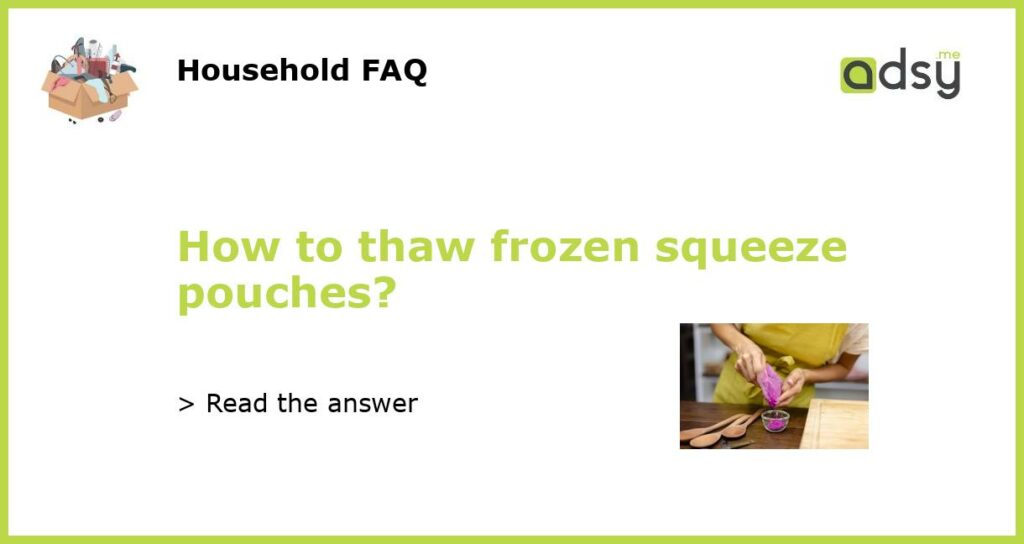Understanding the problem: why squeeze pouches freeze?
Squeeze pouches are a popular option for storing and serving baby food, purees, and other similar products. These pouches are typically made from a combination of plastic and aluminum layers, which helps to keep the contents fresh and prevents spoilage.
However, one common issue that many people face with squeeze pouches is that they can become frozen when stored in low temperatures. This can be problematic, as it becomes difficult to thaw the pouches and serve the contents.
So, why do squeeze pouches freeze in the first place? The primary reason is that the combination of plastic and aluminum layers in the pouches does not provide much insulation. Therefore, when these pouches are exposed to cold temperatures, the contents inside them can freeze.
Now that we understand the cause of the problem, let’s explore how you can effectively thaw frozen squeeze pouches.
Thawing frozen squeeze pouches using natural methods
If you find yourself with frozen squeeze pouches and need to thaw them quickly, there are a few natural methods you can try:
– Room temperature thawing: The simplest method is to place the frozen pouches in a bowl or container at room temperature and allow them to thaw naturally. This process may take some time, depending on the temperature of the room and the size of the pouches.
– Warm water bath: Another effective method is to submerge the frozen pouches in warm water. Fill a bowl or sink with warm (not hot) water and place the pouches in it for a few minutes. Gently massage the pouches to help distribute the heat and speed up the thawing process.
– Heat from your hands: If you’re in a hurry, you can also thaw the pouches by holding them in your hands. The natural warmth from your body can help to slowly thaw the contents of the pouches. However, this method may take longer than the others.
Thawing frozen squeeze pouches using kitchen appliances
If you prefer using kitchen appliances to thaw your frozen squeeze pouches, you have a few options:
– Microwave: The microwave can be a quick and convenient way to thaw squeeze pouches. However, it’s important to be cautious when using this method, as the contents of the pouches may heat unevenly and become too hot in certain spots. To avoid this, remove any metal parts (such as caps) from the pouches and place them in a microwave-safe container. Heat on low power in short bursts, checking and stirring the contents regularly.
– Warm water in a pan: Place the frozen pouches in a shallow pan and cover them with warm water. Heat the pan gently over low heat, stirring the pouches occasionally to promote even thawing. This method requires a bit more time and supervision but can be effective.
– Thawing in the refrigerator: If you have time to spare, thawing the pouches in the refrigerator is a safe and reliable method. Transfer the frozen pouches from the freezer to the refrigerator and allow them to thaw overnight. This method ensures that the contents thaw evenly and safely.
Precautions to keep in mind while thawing squeeze pouches
While thawing squeeze pouches, it’s important to be mindful of a few precautions:
– Avoid using hot water or high heat methods: Exposing the pouches to high heat or hot water can cause the plastic layers to warp or melt, compromising the integrity of the pouches and potentially contaminating the contents.
– Check for any signs of damage: Before thawing and serving a squeeze pouch, inspect it carefully for any signs of damage, such as punctures or leaks. If you notice any damage, discard the pouch immediately to prevent any potential risks.
– Follow the manufacturer’s guidelines: Different brands and types of squeeze pouches may have specific instructions for thawing. Make sure to read and follow the manufacturer’s guidelines for the best results and to ensure the safety of the product.
Storing squeeze pouches to prevent freezing
Prevention is always better than a cure. To avoid dealing with frozen squeeze pouches in the future, consider these storage tips:
– Keep squeeze pouches away from extremely cold temperatures: Avoid storing squeeze pouches in cold areas of your kitchen or refrigerator, such as near the freezer compartment or against the back wall.
– Store pouches in an insulated container: If you have limited storage options, consider using an insulated container or a lunch bag with a built-in cold pack to keep the pouches slightly warmer and prevent freezing.
– Rotate your stock regularly: To ensure freshness and minimize the chances of freezing, regularly rotate your stock of squeeze pouches. Use the “first in, first out” principle to consume the older pouches first.
By following these thawing methods and storage tips, you can effectively thaw frozen squeeze pouches and avoid any wastage or frustration. Remember to prioritize safety and read the manufacturer’s guidelines for the best results.






